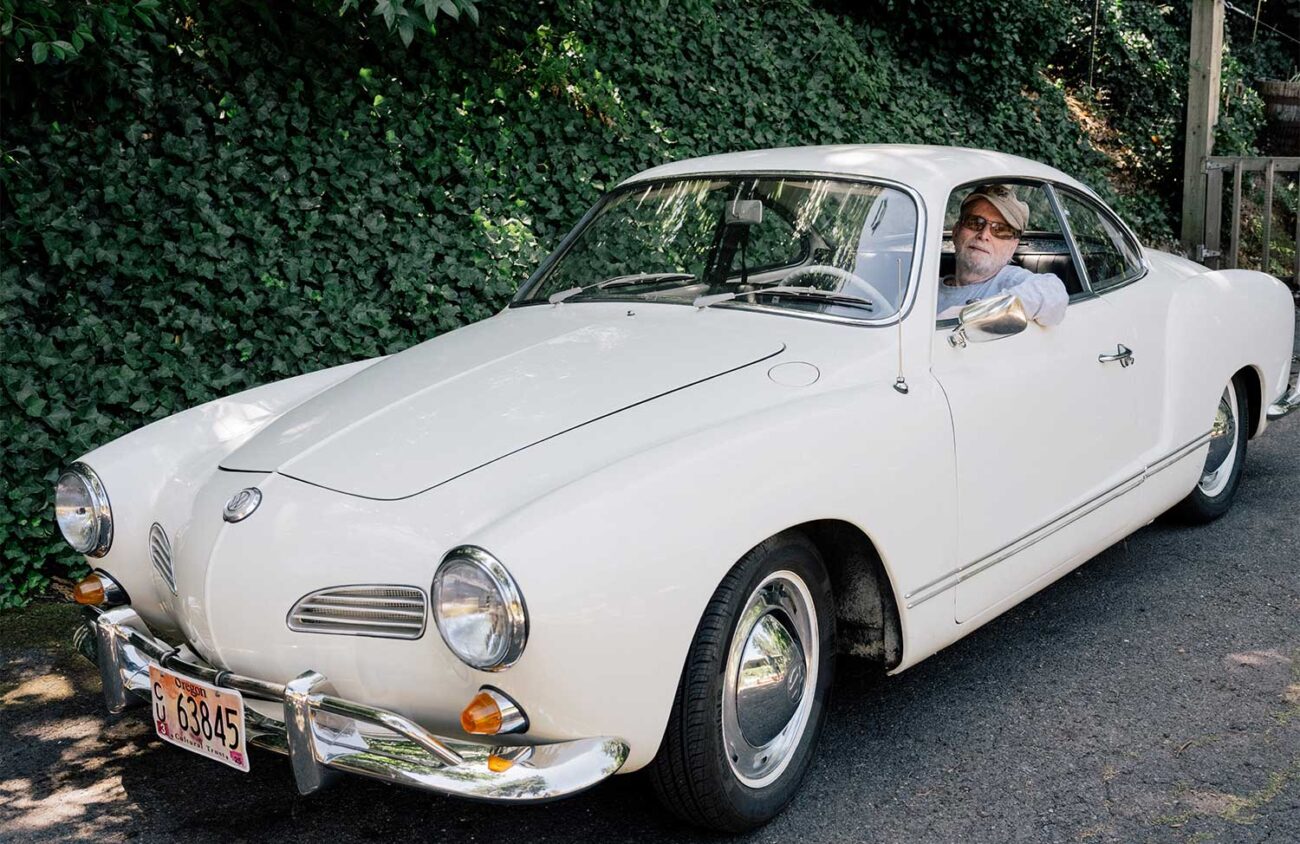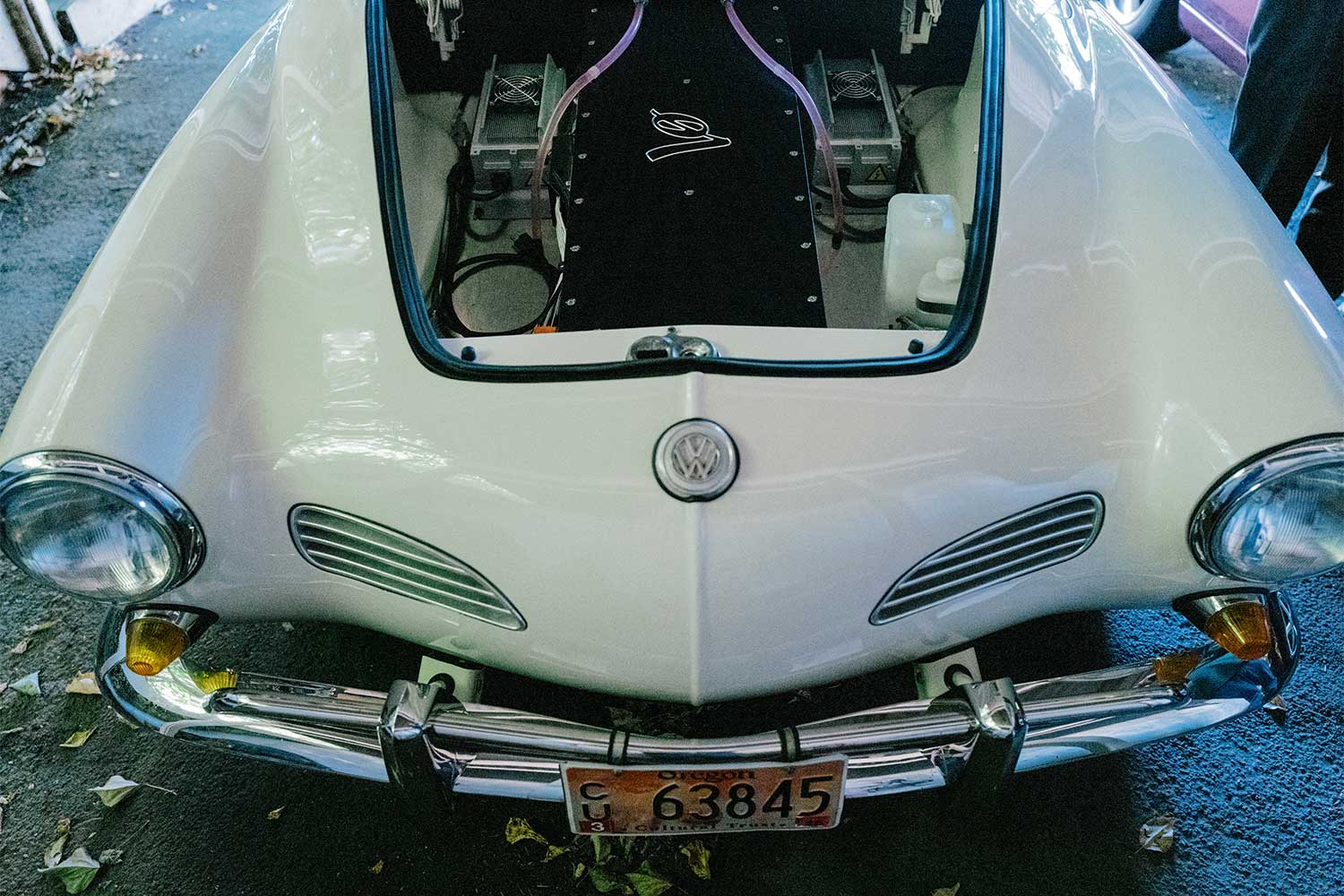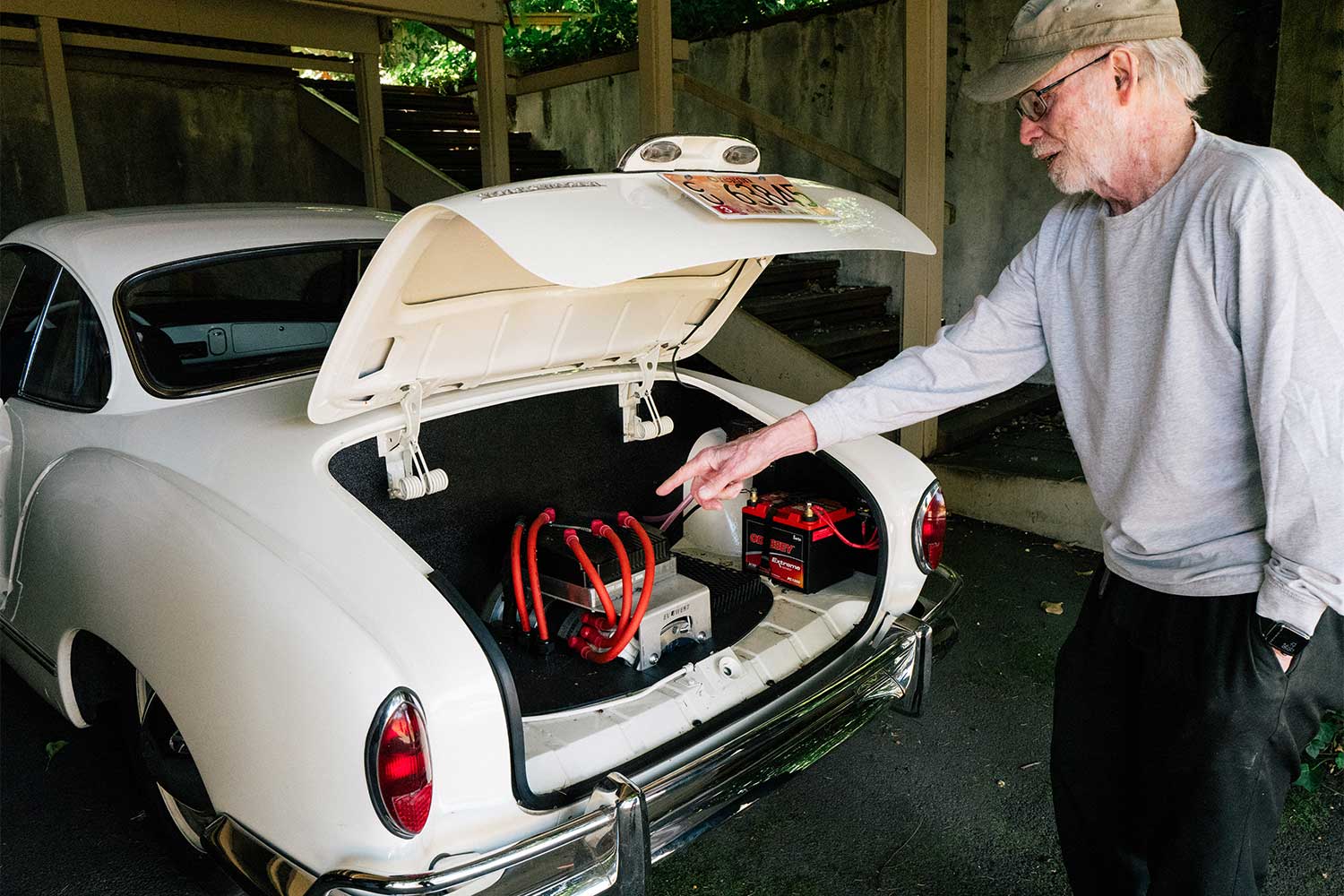When Jerry Diethelm first laid eyes on his Karmann Ghia, it was simply love at first sight. The year was 1965, and he and his wife, Diane Diethelm, were living in Seattle, where Jerry had just gone to work as an architect after finishing a degree from Harvard’s Graduate School of Design.
“I just fell in love with it,” he says of the car, which he bought brand-new right off the lot — not even a test drive — for $2,500. “The Ghia design appealed to me. One of my professors was driving one.”
Fifty-eight years, a career teaching architecture at the University of Oregon and a shade more than 100,000 road miles on his car’s odometer later, we’re standing in the driveway behind the south Eugene home where Diethelm, who is now 84, and his wife have lived since 1970. We’re admiring the Ghia, which has been repainted in the same creamy tone of white as it sported on that day he first saw it. Its chrome bumpers gleam like new. At first we’re silent, as though standing in front of a newly restored masterpiece in a gallery at the Louvre. “It’s always been about its beauty,” Diethelm finally says. “The perfection of its proportions. Well, and as a sports car it was accessible. It wasn’t $80,000.”
The Karmann Ghia is a sleek oddity of the automotive world. Manufactured by Volkswagen in Germany from the early 1950s until 1975, it’s basically a VW Beetle in which that awkward hump of a body has been replaced with the elegance of fine design. The low, understated body was designed by the Italian firm Carrozzeria Ghia, whose clients have also included such high-end car companies as Jaguar, Ferrari and Aston-Martin, and it was crafted by the German firm Wilhelm Karmann, whose client list included Porsche, Mercedes-Benz and BMW. Heady company for the humble Volkswagen “people’s car.”
Never built or sold in large numbers, the Karmann Ghia today is a cult item, appreciated and owned by a select few aesthetes, hipsters and lovers of 1960s-vintage sports cars. Drive one even in Eugene, Diethelm notes, and people are likely to stop and talk with you about it.
In popular culture the Karmann Ghia is perhaps best known for appearing in two scenes in Quentin Tarantino’s 2004 film Kill Bill Vol. 2 — and for the fact that actress Uma Thurman was seriously injured during the movie’s filming when Tarantino insisted she drive a Ghia down a sandy Mexican road. The car went out of control and crashed into a tree, leaving Thurman with a concussion and permanent injuries to her knees. The actress didn’t speak to Tarantino for about the next 15 years.
Diethelm, though, absolutely loves to talk about his car — he’s just spent close to $40,000 to have Eugene mechanic Eric Jones convert it to an all-electric vehicle using two Tesla batteries and a tiny electric motor that is almost lost in the original engine compartment, which is in the rear.
“The two Tesla batteries add 600 pounds of weight to the car,” Diethelm says, opening the front bonnet to display one of them. It looks like a rectangular high-tech suitcase with very sharp corners lying inside the otherwise empty compartment. The other battery is behind the rear seat, for weight distribution. That all makes the car heavier than it used to be. “So I had disc brakes put on.”
He also added contemporary three-point seatbelts, not a stock item on most U.S. cars in 1965, but admits this is still a vehicle without such standard 21st-century safety features as anti-lock brakes, airbags or a crushable front end to absorb the force of a collision. His car never had a radio, so he put one in. The car also lacks power steering, which, he notes, means you turn the steering wheel only while the car is in motion. “You have to get used to driving again.”
His refurbed Ghia can manage about 100 miles on a single battery charge, he says, meaning it’s pretty much a town car. With the help of a $500 EWEB subsidy, he put a charging station in his carport. An electric fill-up, when the batteries are down to 20- to 30-percent charge, takes about five hours, he says.
Jones, who has run Eric Jones Motorsports in Eugene since 2005, specializes in Porsches and Ferraris. He had never converted a gasoline-engine car to electric power before Diethelm, who knew of him through a mutual Porsche-owning acquaintance, approached him two years ago.
“It was definitely a learning experience,” Jones says. “I had never done one before, and I haven’t done one since. It was like a horse doctor learning to work on goats.”
For that reason, Jones bought the parts in a kit, even though he knew he could buy them all separately. Buying the $18,000 kit gave him someone to call for advice on the conversion, and call he often did. ”I knew I would need some help,” he says. “Electrical is probably my weakest area.”
Though he calls himself a “gasoline guy,” Jones says he likes electric cars, and would like to see some of the environmental issues worked out.
The original 1.2 liter Volkwagen engine in Deithelm’s Karmann Ghia put out a whopping 39 horsepower — about three times as much as an old garden tiller — but the electric motor that now runs the car is rated at 120 horsepower, meaning that if Diethelm were into drag racing he could pop right off the line. He could even burn rubber.
Diethelm admits he hasn’t tried that. “A younger Jerry could,” he says, “and would probably be on his second set of tires. But I’ve forgotten how.”
Since he got it back from Jones’ shop in June, Diethelm has driven his car at only up to 70 mph, though its specs say it can manage 100. His converted Ghia still has its original four-on-the-floor manual VW transmission, along with a clutch and now seldom-used clutch pedal. He keeps it in second gear, except now and then on the freeway he might shift into fourth.
Diethelm’s custom Ghia conversion is just the tip of the iceberg in a rapidly growing business of converting classic internal-combustion cars of the past to run on batteries.
One local businessman riding that frenetic wave is Joe Potter, owner of Vintage Underground, a Eugene firm that restores classic cars such as older Porsches and Jaguars. He says electric vehicle conversions have become common over the past four decades, but that the technology for EVs — especially batteries — has dramatically improved in the past two years.
As a result, he and his 32 employees have begun to expand their services from rebuilds and restorations of classic cars to EV conversions. “I would expect in three to four years that will be 35 to 40 percent of our business,” he says.
Vintage Underground’s initial foray into EV conversions has been with a classic Mini and an E-type Jaguar. Both projects are nearing completion, he says, but both proved challenging. Adding heavy batteries to the Jaguar, for example, required re-engineering its suspension to handle the new weight, and the high torque of an electric motor meant the traditional wire-spoke wheels could not be used on the Jag, changing its appearance.
In the end, Potter says, the chaos of new technology is also an opportunity. “The technology has caught up to the point where we can make some seriously entertaining machines,” he says.
Diethelm, though, doesn’t much care about owning a new and entertaining machine. He’s happy to restore his half-century-old car to its former elegance, while improving its environmental friendliness.
“I wasn’t interested in buying a new car,” Diethelm says. “And so I merged a growing interest in EVs to some needed upgrading of my Ghia.”


